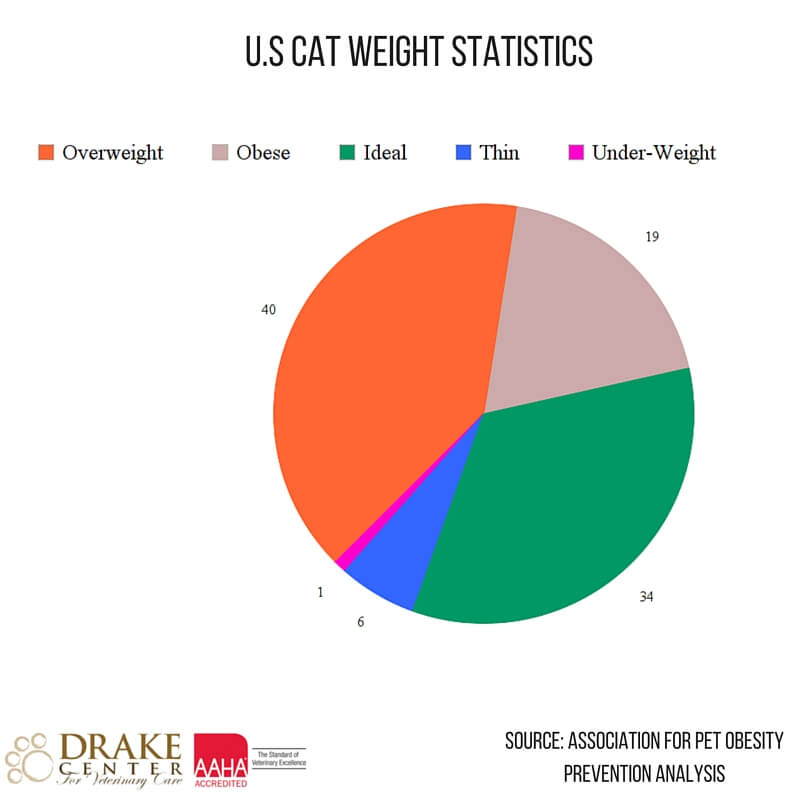Is your kitty looking a little chubby? According to the Association for Pet Obesity Prevention (APOP), a staggering 59 percent of cats in the United States are overweight or obese. These conditions can predispose our feline friends to a number of serious health issues, including diabetes, hepatic lipidosis (fatty liver disease) and arthritis.
Unfortunately, however, many cat owners are simply unaware that their pets are overweight. In fact, a recent APOP survey showed that 45 percent of pet owners with overweight pets believe their pets are actually a healthy weight.

Several factors can contribute to weight gain in cats. Weight changes often happen very gradually and can be difficult for pet owners (who typically see their cats on a daily basis) to recognize. Indoor cats especially have a tendency to become sedentary as they age unless they are engaged in daily activity. Compared to canned diets, kibble is also very calorie dense and easy to inadvertently overfeed. Caloric requirements decrease in cats after neutering and spaying and again as pets begin to age and slow down. Of course, genetics also play a significant role in feline obesity.
So, how can we combat the feline bulge? Just as in humans, the answer comes down to diet and exercise.
Diet:
There are several options when it comes to adjusting your cat’s diet for weight loss.
Simple calorie reduction is the most commonly used strategy. Appropriate caloric restriction in cats should result in the loss of one to two percent of body weight per week. This amounts to about one-half to one pound per month. If you are not achieving adequate weight loss, don't hesitate to reduce your cat’s food intake by 10 percent per week until successful.
If you currently feed kibble, making the switch to a canned diet can help dilute calories using water. This can be challenging, but many helpful tips exist to make the transition easier.
Dividing your cat’s daily allotment of food into multiple meals can also increase the amount of calories burned as well as influence your cat’s perception of hunger. It is important to control portions by accurately measuring your cat’s food at each meal.
In multiple cat households, each cat should be fed separately. This is much less stressful for the cats and ensures each cat eats only his/her allotted portion.

Your cat’s body weight should be monitored every other week at home using a scale that weighs to one tenth of a pound (0.1 pound). Using a traditional scale, first weigh yourself and then weigh yourself holding your cat. Calculate your cat’s weight by subtracting the first number from the second. Baby scales are also great for accurately measuring your cat’s weight. If you cannot weigh your cat at home, you can always stop by your veterinarian’s office for regular weight checks.
Be aware that it can take a few months for your cat’s weight loss to begin. Your veterinarian can help you with guidelines on the number of calories to start with for your cat’s body size. It can also be very helpful to keep a journal of your pet’s food intake and weight during this time.
In addition to caloric restriction, fiber-rich or protein-based diets can help promote weight loss in cats.
Increasing dietary fiber has been shown to decrease voluntary food intake as well as the desire to eat. Many weight-loss formulas contain between 10 to 15 percent dietary fiber, which provides bulk, dilutes calories and promotes a sense of fullness.
Not all cats tolerate fiber-enhanced foods without complication, however. Increased stool volume, food refusal, constipation, dry skin and unacceptable begging behavior have been associated with weight-reduction foods in some cats.
Similar to the Atkins diet in humans, high protein, low carbohydrate foods are often used for “metabolic control” in cats. Theoretically, this allows the body to use fat (not carbs) as the cat’s primary energy source.
The benefits of this approach include appetite control, increased calorie loss, improved insulin sensitivity and weight loss. This method may also preserve more lean muscle mass.
Like humans, not all cats lose weight the same way. Unfortunately, there are no markers to tell us which strategy will work best in individual cases and in fact, some cats will not respond to either method.
Regardless of the approach, calories are still the most important factor to watch for weight loss — and the odds of success increase substantially when exercise is increased at the same time.
Exercise:
Lack of exercise in indoor cats is considered a major contributor to the obesity crisis.
Because the energy requirement for inactive pets is approximately 20 to 40 percent less than that of moderately active animals, increasing activity is needed to directly influence the cat’s metabolic rate. It has been shown that a simple 10-minute play session per day is as effective as diet restriction in cats. We recommend two five to 10-minute play sessions per day to keep cats lean and active, as well as to combat boredom.

Often, however, indoor cats can become quite “shut down” and it may be difficult to elicit play behavior. Don’t give up. Rotate toys and games so your cat does not get bored. Design feeding strategies that involve the cat climbing or searching for his/her food. Puzzle feeders can also be used to increase activity and calories burned during feeding. Use your imagination to get your cat moving again. More than likely, curiosity will drive them to see what you are up to.
For more ideas, check out our environmental enrichment handout here.
This article first appeared on: The Drake Center Blog
